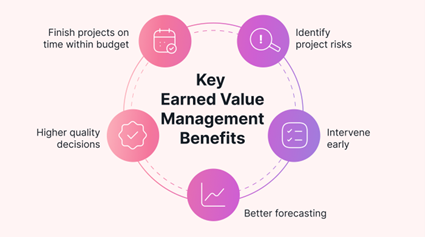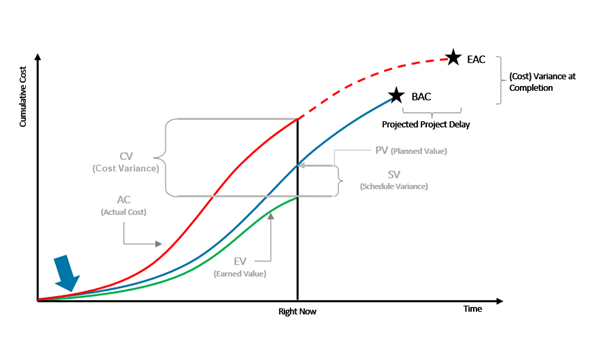When a project is underway, and a detailed plan has been established to outline the time required for specific deliverables, it’s common for things to deviate from the original plan. This unpredictability is inherent to projects because accurately estimating timeframes is challenging.
Project management offers a valuable tool for monitoring progress: Earned Value. This method, employed by Key to oversee projects, involves tracking the amount of work completed and the actual progress achieved.
To illustrate, consider a task scheduled to take 5 days. According to the plan, after 3 days, you would expect to have completed 60% of the task. However, you might only have finished 30% due to unexpected issues or underestimated complexity. This is where Earned Value analysis becomes crucial.
Earned Value measures three main numbers:
- Budgeted Cost of Work Scheduled, also known as Planned Value, represents your planned cost. To illustrate, let’s assign a daily cost of $1,000 to the example. By day three, your Budgeted Cost of Work Scheduled amounts to 3 days x $1,000 = $3,000.
- Budgeted Cost of Work Performed, also known as Earned Value, reflects the cost corresponding to the progress achieved. For instance, if you’ve completed only 30% of a task with a total cost of $5,000, then the Budgeted Cost of Work Performed is 30% of $5,000 = $1,500.
- Actual Cost of Work Performed, simply referred to as Actual Cost, measures the real expenses incurred during the project. For example, to achieve that 30% progress, you might have needed an additional hour of work at a rate of $100. Thus, the Actual Cost of completing 30% of the task in 3 days amounts to $1,600 ($1,500 for three days plus an extra $100).
Now you have the main EVM numbers:
- BCWS (Planned Value) = $3,000
- BCWP (Earned Value) = $1,500
- ACWP (Actual Cost) = $1,600
It becomes evident that less value has been generated than planned (Earned Value is lower than Planned Value), and more spending has occurred than intended (Actual Cost is higher than Earned Value). To facilitate the understanding of these discrepancies, two key metrics come into play: Schedule Variance and Cost Variance.
Schedule Variance [%]=(BCWP-BCWS)/BCWS x100=(Earned Value-Planned Value)/(Planned Value)
This metric illustrates the extent to which the project deviates from its planned trajectory by comparing actual progress to the initial plan. In our example:
Schedule Variance [%]=($1,500-$3,000)/$3,000 x100= -50%
In the example provided, the negative number indicates that the activity is behind schedule, deviating by 50% from the planned progress at the considered moment.
Cost Variance [%]=(BCWP-ACWP)/BCWP x100=(Earned Value-Actual Cost)/(Earned Value) Cost Variance [%]=(BCWP-ACWP)/BCWP x100=(Earned Value-Actual Cost)/(Earned Value)
Similarly, this metric demonstrates the variance between the actual cost incurred and the expected cost for the progress achieved. In our example:
Cost Variance [%]=($1,500-$1,600)/$1,500 x100= -6.67%
The negative number indicates an overspending of 6.67% compared to the projected cost based on the actual progress. Ideally, both metrics should be positive and as close to zero as possible, indicating alignment with the original plan.
Schedule Variance [%]=(BCWP-BCWS)/BCWS x100=(Earned Value-Planned Value)/(Planned Value)
This metric illustrates the extent to which the project deviates from its planned trajectory by comparing actual progress to the initial plan. In our example:
Schedule Variance [%]=($1,500-$3,000)/$3,000 x100= -50%
In the example provided, the negative number indicates that the activity is behind schedule, deviating by 50% from the planned progress at the considered moment.
Cost Variance [%]=(BCWP-ACWP)/BCWP x100=(Earned Value-Actual Cost)/(Earned Value) Cost Variance [%]=(BCWP-ACWP)/BCWP x100=(Earned Value-Actual Cost)/(Earned Value)
Similarly, this metric demonstrates the variance between the actual cost incurred and the expected cost for the progress achieved. In our example:
Cost Variance [%]=($1,500-$1,600)/$1,500 x100= -6.67%
The negative number indicates an overspending of 6.67% compared to the projected cost based on the actual progress. Ideally, both metrics should be positive and as close to zero as possible, indicating alignment with the original plan.
Schedule Variance [%]=(BCWP-BCWS)/BCWS x100=(Earned Value-Planned Value)/(Planned Value)
This metric illustrates the extent to which the project deviates from its planned trajectory by comparing actual progress to the initial plan. In our example:
Schedule Variance [%]=($1,500-$3,000)/$3,000 x100= -50%
In the example provided, the negative number indicates that the activity is behind schedule, deviating by 50% from the planned progress at the considered moment.
Cost Variance [%]=(BCWP-ACWP)/BCWP x100=(Earned Value-Actual Cost)/(Earned Value) Cost Variance [%]=(BCWP-ACWP)/BCWP x100=(Earned Value-Actual Cost)/(Earned Value)
Similarly, this metric demonstrates the variance between the actual cost incurred and the expected cost for the progress achieved. In our example:
Cost Variance [%]=($1,500-$1,600)/$1,500 x100= -6.67%
The negative number indicates an overspending of 6.67% compared to the projected cost based on the actual progress. Ideally, both metrics should be positive and as close to zero as possible, indicating alignment with the original plan.
Schedule Variance [%]=(BCWP-BCWS)/BCWS x100=(Earned Value-Planned Value)/(Planned Value)
This metric illustrates the extent to which the project deviates from its planned trajectory by comparing actual progress to the initial plan. In our example:
Schedule Variance [%]=($1,500-$3,000)/$3,000 x100= -50%
In the example provided, the negative number indicates that the activity is behind schedule, deviating by 50% from the planned progress at the considered moment.
Cost Variance [%]=(BCWP-ACWP)/BCWP x100=(Earned Value-Actual Cost)/(Earned Value) Cost Variance [%]=(BCWP-ACWP)/BCWP x100=(Earned Value-Actual Cost)/(Earned Value)
Similarly, this metric demonstrates the variance between the actual cost incurred and the expected cost for the progress achieved. In our example:
Cost Variance [%]=($1,500-$1,600)/$1,500 x100= -6.67%
The negative number indicates an overspending of 6.67% compared to the projected cost based on the actual progress. Ideally, both metrics should be positive and as close to zero as possible, indicating alignment with the original plan.
While this example pertains to a single task, the same principle applies to the entire project, offering a valuable graphical tool for interpreting the project’s performance over time.
Earned Value Graph
This method also offers additional useful metrics like EAC (Expected at Completion). EAC predicts the expected total expenditure by the end of the project if current cost trends persist. This allows the project manager to forecast the completion cost and implement necessary measures to realign the project if needed.
By following the principles of Earned Value, you can ensure an accurate control of the project and take the necessary steps to bring it back on track.



Recent Comments